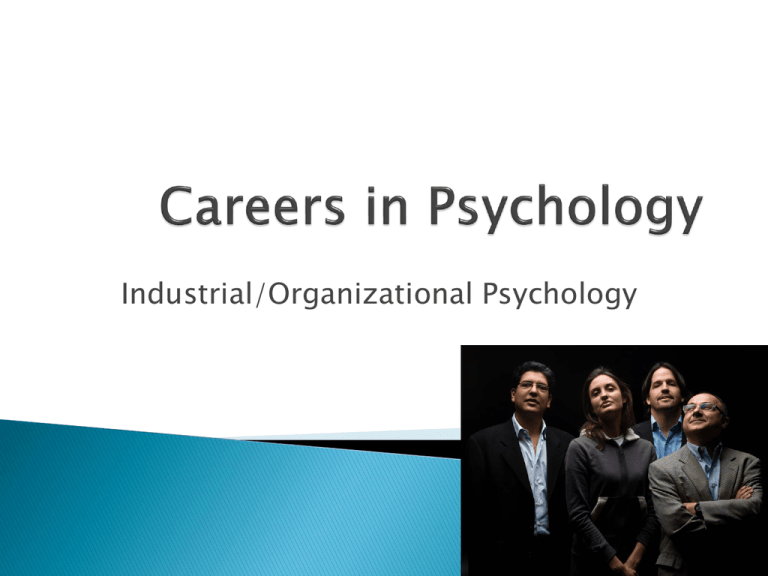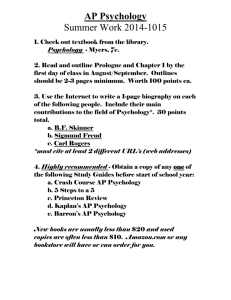Careers in Psychology
advertisement

Industrial/Organizational Psychology 1. Hugo Munsterberg – “Father” of Industrial Psychology In 1911, cautioned managers to be concerned with “all the questions of the mind … “ First to encourage government funded research in industrial psych. In 1913, published Psychology and Industrial Efficiency Persons need to fit organizations Behavioral science can help organizations shape better-fitting employees New employees can serve as “replacement parts” for the organizational machine 2. Frederick W. Taylor – First “Efficiency Expert” Argued for redesign of workplace to achieve higher productivity Conducted first time and motion studies of worker behavior In 1911, published The Principles of Scientific Management Work methods should be designed scientifically to maximize efficiency The best workers should be selected, then trained in the best work methods Showed iron workers more productive if given rest periods: *Productivity increased almost 4-fold *Production cost dropped by more than 50% 1. 2. Inhumane exploitation of workers to increase profits Increased unemployment because fewer workers needed to do same amount of work First World War Ends Complaints! 3. Robert Yerkes – “Father” of group testing In 1917, proposed ways of screening army recruits for mental deficiency and assigning to specific army jobs Created Army Alpha and Army Beta penciland-paper intelligence tests 1917 – Journal of Applied Psychology first published 1921 – James McKeen Cattell founds The Psychological Corporation to promote usefulness of psychology to industry 1924 – Hawthorne Studies conducted to identify factors increasing productivity 1933 – Elton Mayo demonstrates importance of employee attitudes and employer sensitivity 1932 – Morris Viteles publishes Industrial Psychology, first use of that phrase in print 1939 – Kurt Lewin publishes first empirical study of effects of leadership style 1941-1945 – I/O psychologists help army develop General Classification Test for draftees OSS (precursor to CIA) develops stress and other assessment tests for candidates to be agents 1945 – Kurt Lewin forms Research Center for Group Dynamics at MIT (later moved to U. of Michigan) 1946 – I/O psychologists form Division 14 of APA 1950’s – Skinner initiates discussion of behaviorism applied to the workplace 1960’s – David McClelland (and others) propose various theories of achievement motivation 1970’s – Skinner (in Beyond Freedom and Dignity) advocates b. mod. strategies to motivate persons in organizations Porter and Lawler propose expectancy model of motivation in the workplace 1980’s to present – Explosion of I/O research and application “The general practice specialty of professional psychology with a focus on scientifically based solutions to human problems in work and other organizational settings.” Core undergraduate education in 1. 2. 3. 4. 5. 6. 7. Biological bases of behavior Cognitive-affective bases of behavior Social bases of behavior Individual differences Research methods Psychological/behavioral measurement Statistical methods Advanced (graduate) education in 1. Ethical/legal issues in the practice of I/O psychology 2. Consulting and business skills 3. Attitude theory 4. Career development 5. Consumer behavior 6. Health/stress effects on individuals in organizations 7. Human factors and performance (a la Taylor) 8. Individual/group/organizational assessment methods 9. Job/task analysis 10. Job evaluation 11. Work motivation and compensation 12. Leadership and management theory 13. Organizational theory 14. Training theory and program design/evaluation Job/task analyses Development/validation of organizational policies/procedures Analyses of employee morale, job satisfaction, and organizational environment Leadership and team development Management consultation and coaching Human resource planning and policy analyses Expert testimony in employer/employee disputes, such as sexual harassment cases





